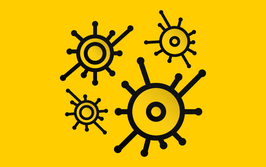Animal-Free; Risk-Free
If you or your supplier are working with animal-derived components then you run the risk of exposing patients to dangerous contaminations.

The risk of contamination is ever-present. Any given product, at any time – even when manufactured under cGMP and a robust Quality Management System can fall foul to the effects of contamination. The most at-risk products are those derived from biological sources, such as biopharmaceuticals, human cells, tissues, and cellular and tissue-based products (HCT/Ps). Therefore, donor tissues and cells can pose significant problems. “Title 21” of the FDA’s Code of Federal Regulations (21 CFR Part 1271) contains requirements for screening donations of human cells and tissues for relevant communicable disease agents or diseases, such as human immunodeficiency virus, hepatitis B virus, hepatitis C virus, and human transmissible spongiform encephalopathy.
The screening of donor tissues and cells is a critical step in the lifecycle of HCT/Ps. Transplantation and processing of donor tissues and cells cannot occur if a donor is shown to have risk factors for, and clinical evidence of, infection due to relevant communicable disease agents and diseases after thorough screening.
And after such rigorous testing, why then would you risk the reintroduction of one of these communicable diseases into your tissues and cells? Though this question may sound absurd, the risk is real, especially for Creutzfeldt-Jakob disease (CJD).
CJD is a rare, degenerative, fatal brain disorder. It affects about one person in every one million per year worldwide; in the US there are about 350 cases per year. CJD usually appears in later life and runs a rapid course. Typical onset of symptoms occurs around the age of 60, and about 70 percent of individuals die within one year.
There are three major categories of CJD. Sporadic is the most common type of CJD and appears even though the person has no known risk factors for the disease. In hereditary CJD, the person may have a family history of the disease and test positive for a genetic mutation associated with the disease. In acquired CJD, the disease is transmitted by exposure to brain or nervous system tissue, usually through certain medical procedures.
Both sporadic CJD and acquired CJD can be acquired by ingesting or by being exposed to contaminated tissues and/or contaminated animal derived products. In some cases, CJD has spread to other people via grafts of dura mater (a tissue that covers the brain), transplanted corneas, implantation of inadequately sterilized electrodes in the brain, and injections of contaminated pituitary growth hormone (derived from human pituitary glands taken from cadavers).
Although 21 CFR part 1271 contains requirements regarding donors, the document does not address the risks of introducing CJD during the recovery or processing of HCT/Ps from contaminated animal-derived products. For this, you need to look to your suppliers.
Strong epidemiologic and laboratory evidence exists for a causal association between CJD and Bovine Spongiform Encephalopathy (BSE) in cattle. It is possible for humans to contract CJD via contaminated animal-derived products from cattle affected by BSE. CJD and BSE are both prion diseases and there is strong scientific evidence that the agent responsible for the outbreak of BSE in cattle is the same agent responsible for the outbreak of CJD in humans. Currently, the most accepted theory is that BSE is a modified form of a normal protein known as prion protein. For reasons that are not yet understood, the normal prion protein changes into a pathogenic form that then damages the central nervous system.
Severe restrictions have been put in placed on the importation of live ruminants and certain ruminant products from countries where BSE is known to exist to prevent the disease from entering the US, but because the nature of the transmissible agent is not well understood, this is merely a means to mitigate the risk, not eliminate it.
The pharma industry has also put in place steps to help eliminate the dangers posed by contaminated animal-derived components, but only after they had to learn some hard lessons in this area following the heparin scandal.
In January 2008, the US health system authorities began to receive isolated reports of hyper-sensibility reactions in hemodialysis patients. Symptoms included hypotension, facial inflammation, tachycardia, hives, and nausea. Initially, enquiries focused on the filters and lines used in dialysis; however, research carried out by the CDC proved that all known cases had in common the use of sodium heparin. By February of the same year, the manufacturer of the sodium heparin withdrew all batches of the product, but not before some patients died.
The FDA published the analytic methods to detect contaminated heparin batches in March 2008, which revealed a high degree of contamination. The FDA’s investigation showed that the manufacturer and other suppliers had bought heparin from a single supplier, which, in turn, sourced the heparin from its factory based in China. The contaminant was in the heparin material before it reached the supplier. Since the Chinese factory sourced its raw heparin from various small suppliers, full traceability of the heparin supplies was not possible.
In response to the contamination issue, extensive revisions were made to the unfractioned heparin monographs of both the US and European Pharmacopeias, and it also led to more scrutiny of supply chains. In my view, today there is still the potential for pharmaceutical finished dosages to be contaminated with animal-derived products; for example, some APIs, starting materials and primary packaging materials involve the use of products/materials derived from animals:
The use of proteins, enzymes, amino acids from animals used in the manufacturing of API and API starting materials.
Primary packaging materials, such as like gelatin capsules, are derived from the fat of animals.
For biotechnological products like serums, blood products and vaccines, source material can be derived from animals.
There is also a possible risk of BSE contamination through equipment/utilities where biologically-derived products and/or products of animal origin are handled, such as culture media used in reactors for media fill studies, or reagents manufactured in a non-animal origin free facility.
The use of such animal-derived products is accepted, provided that the manufacturing process and procedures comply with the applicable regulations set by the World Health Organization (WHO), the European Commission and the FDA. However, where possible, the use of animal-derived products should be avoided when manufacturing products used to diagnose, treat, or cure patients. The best way to eliminate the risk of BSE and other contaminations resulting from animal-derived products is to maintain an animal-origin-free facility – and, importantly, life science companies should hold their suppliers to the same standards. If you choose to rely on a supplier that doesn’t maintain an animal-origin-free facility, you are in danger of introducing contamination. For me, the choice is obvious.



















